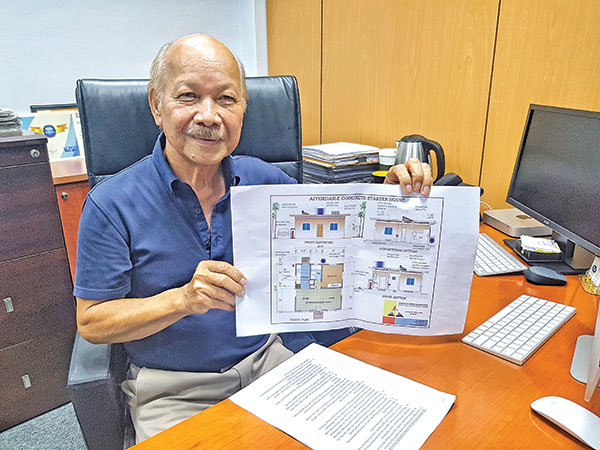NMI architect promotes typhoon-proof homes

Architect Herman B. Cabrera, a seasoned architect, has seen many strong storms go through the CNMI and Guam. “The ‘affordable concrete starter house’ is designed based on those experiences. …I don’t want to see the CNMI in rubble after every typhoon and something must be done.” he said. (Bea Cabrera)
It has been 36 days since Super Typhoon Yutu hit the CNMI. Half of Saipan and the entire island of Tinian is still struggling to pick up the pieces.
The sight of so many destroyed buildings and scattered debris from roofless houses prompted architect Herman B. Cabrera to go to his drafting table, examine the elements of what would be needed to build durable homes, and eventually come up with what he calls “Affordable Concrete Starter House.”
“What compelled me to go out and convince the community to go concrete was the damage all over island. After the typhoon, our island turned into rubble and my heart goes out to all those who were affected,” he said. “Many people are not wisely informed how to build better and durable homes. …As an architect, I have the technical knowledge and my intention is to share or advise both the government and community in building a stronger and permanent dwelling structure.”
His design is intended for low-income families. The size of the house is 576 square feet, where both the roof and walls are made out of concrete. It includes living and dining rooms, one bedroom, a kitchen, and a toilet and bath.
What is unique about this 24×24 house, Cabrera said, is that it is self-sustaining and economical. “The size of the house meets the International Building Code and our CNMI regulations.”
The kitchen is designed to be economical as the gas range space can fit a 90-lb gas range that can make a gas tank last a year. The bathroom has a toilet, shower, and bathtub and the water used in the entire house will come from a built-in tank with enough water pressure to source it from Commonwealth Utilities Corp. water.
In the event that there is no CUC water, the 300-gallon tank will still be able to supply water to the shower, toilet, and kitchen using gravity.
A cylinder at the bottom of the house is also built to collect rainwater so this water catchment can supply water for several months to a year.
As for power, the house comes with a solar panel with 420 watts and a 30-gallon solar water heater. The roof will be insulated so the heat will not travel to the rooms.
Cabrera said this design can withstand a Category 5 typhoon and one unit with all of the basic features will cost approximately $45,000.
“I have the basics in my own house, so everything is tried and tested from personal experience… This is not expensive to have and to maintain.”
“The design also has provisions for a modified version in case the family wants to expand and add a room and a carport, but this basic house is possible for everyone,” he added.
Cabrera believes that now is the time for the government to look seriously into building concrete houses and infrastructure. “We don’t want the CNMI to turn into rubble after every typhoon. …A perfect partnership would be between the government and private businesses to ensure the CNMI has stronger infrastructure,” he said.
“In the mainland, there is an organization called Habitat. …I hope we can organize something like that here and that is the responsibility of the government,” he added.
According to Cabrera, the Federal Emergency Management Agency and Small Business Administration should work together on this.
“Sometimes FEMA go out and…they give homeowners, say, $15,000 to $20,000 but how can you build a house [with that]? But if FEMA and SBA will get together, whatever balance that is needed to build the house, SBA can come in,” he said.
“I also hope that the government will start to regulate the hardware stores… They are selling fir wood, which is very soft wood and can break in hundred-miles-per-hour wind and, with the recent super typhoon, you are done. Even treated, termites eat them. Most Chalan Kanoa houses were built with this kind of wood,” he added.
For more information about Cabrera’s design, he can be reached via 287-1778 or email him at hbcabrera@gmail.com.



























